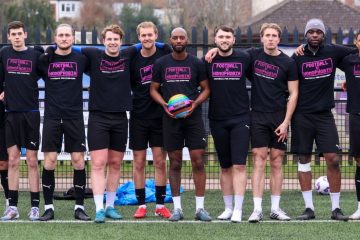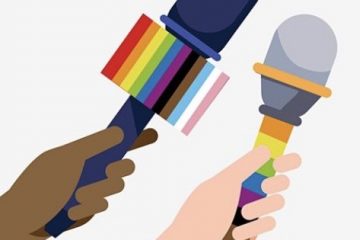It’s good to talk about being gay in football

Sports media professionals are being given the opportunity to discuss LGBT inclusion with the Premier League and Stonewall. It’s a chance our industry shouldn’t squander, writes Sports Media LGBT+ network lead Jon Holmes…
You may remember the Daily Star‘s front-page splash on a Tuesday in late October last year. ‘SECRET OF TWO GAY PREM FOOTIE ACES’ ran the headline, peculiarly overlaid on an image of a pregnant, smiling Coleen Rooney in a bikini, and a sub-header saying ‘Not Rooney obviously!’ Mentioning Wayne in this way was, fortunately, not the start of a lengthy process of elimination, but it did still provoke the usual frenzy of speculation. The coverage also drew considerable criticism on social media, some of which was collated in this Pink News article.
DAILY STAR FRONT PAGE: 'Secret of two gay Prem footie aces' #skypapers pic.twitter.com/zGfF4fQ3Ko
— Sky News (@SkyNews) October 23, 2017
The tabloid story was incorrectly labelled ‘exclusive’, in that rather desperate way such stories often are; the quotes actually came from a Belgian newspaper called De Zondag, in an interview with former Stoke and West Brom defender Carl Hoefkens that had run the previous Sunday. They’d been picked up by the majority of UK sports media outlets on the Monday, including the digital publisher I work for, Sky Sports. In the interview, Hoefkens had talked about former team-mates of his who were gay and out to their colleagues, but who wanted to maintain their privacy. He had initially been asked a question about posing on the cover of a gay magazine in 2012, and said he had done so to help try and break the taboo of talking about homosexuality in football. He then referred to the gay men he had happily played alongside, adding there were such instances in both his homeland and in England – but went no further out of respect for the players’ privacy.

Hoefkens’ motivations for even mentioning this were criticised by some, but in the context of the original interview, it read to me like an ally of LGBT people trying to give a helpful answer to a direct question from the media – in short, ‘I know for a fact there have been gay players in football dressing rooms, and in my experience, it wasn’t a problem’. Yet the sensational spin and story placement of the Star two days later distorted that message, and baffled Hoefkens, who wrote on Twitter: “The fact that there is so much attention for what i said in the media shows to me that #blackwhiteyellowbrownlesbiangay are still approached in a different manner which is a true shame”.
Shame – the word that’s often used about the lack of openly gay or bisexual male professional players. “It is a crying shame that top-flight football remains one of the last places where gay men are too afraid to come out,” ran an editorial in The Sun earlier this month, commenting on their own article – another front-page lead – about an unnamed international player who had been in a four-year relationship with a fashion worker who is gay. The latter was talking to the paper “in a bid to widen the discussion on homophobia in football”. The Sun has also published two stories in recent weeks on homophobic bullying at a Premier League club, again unnamed.
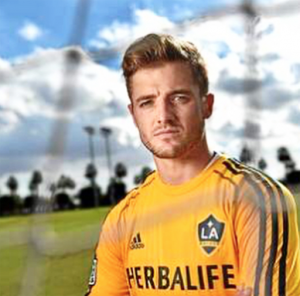
All the players involved in these stories will have felt shame – not just the regret of a sad situation, but the pain and distress of being different in a world where acceptance of that difference is not yet guaranteed. “As a young boy, I dreamed of becoming a professional soccer player and representing my country in front of the world,” wrote Robbie Rogers upon his retirement from the game in November. “But as a teenager, I grew more and more consumed by fear and shame.”
Rogers was a fine footballer, who should have won more than 18 international caps for the USA. But the shame he carried with him held him back. “Being closeted was affecting the way I played,” he told Flaunt Magazine in February 2015, reflecting on his time at Leeds United. “It was affecting my relationships. It just really destroys you – your mental health and your confidence.” Recently, stories shared in Mental Health Awareness Week have reminded us of the risks posed to under-pressure athletes by addiction – drinking, drugs and gambling are all toxic temptations that can ruin lives. But there has been little talk of the shame felt by closeted gay or bi men, like those in some of the recent tabloid stories. While it’s wrong to generalise about the mental health problems of LGBT people, they are statistically more susceptible to depression and loneliness, while being in the closet inevitably adds more layers of introspection. By its very nature, the case of the closet is a hidden crisis in our game.
Even though I was always realistic about my own ambitions in football (I accepted I would never play for Plymouth Argyle so started writing instead), Rogers’ story has always resonated with me. After a standard Church of England education, I worked in a male-dominated sports newsroom where diversity and inclusion were never mentioned, let alone discussed. No one was particularly to blame for that – office culture then was very different to now – but I struggled in the environment because I was consumed by fear and shame too. A couple of incidents early on in my journalism career, when colleagues had suggested that I was gay – in a way that was not encouraging – helped keep my own closet door firmly shut. Knowing no other gay men, and with no signs that life would be better out in the open, I stayed in my closet for years, along with my shame. Five years ago, I met a wonderful guy who let me out. The only shame I feel now is the regret of the wasted years, the effort spent on trying to be someone I wasn’t, and the missed opportunities that came with it.
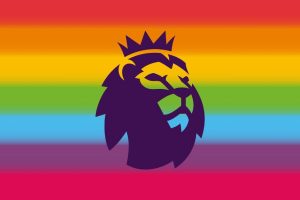
Through media and journalism, I want to try and help create a climate in sport and sports media where shame is neither felt nor facilitated. For the last two years, I’ve been writing about the different experiences of LGBT people in sport – at both professional and grassroots levels – for my employer, Sky Sports. I’m really grateful to have been given space to explore that, and I’ve had great support from Stonewall and our TeamPride partners on the Rainbow Laces campaign. The Premier League are now six months into their own partnership with Stonewall, and this week they’re convening a meeting with editors, broadcasters and journalists to discuss the media’s role on aiding LGBT inclusion in sport. It’s a welcome opportunity to have a mature conversation about how we all report on lesbian, gay, bisexual and transgender people in sport – on the back pages, the front pages, on digital or on social – and the impact that has on individuals and organisations, both positive and negative.
It’s important to highlight that there are many good examples of LGBT-related stories in the UK sports media. When The Guardian‘s Donald McRae was named Sports Feature Writer of the Year by the Sports Journalists Association in February, his skill in writing about “being gay in sport” was praised by the judging panel, noting that he displayed a “rare sensitivity” in his interview technique. When football referee Ryan Atkin came out publicly as gay in August 2017, there was widespread coverage of his story and its significance. The Rainbow Laces campaign continues to be discussed in opinion columns, along with examination of its impact. In the last year, I can recall several powerful articles featuring people involved in sport who are lesbian, gay, bi or trans, such as Hugo Scheckter, Philippa York, Mark Foster, Liam Davis, Victoria Smith and the players of Charlton Invicta FC. There’s a limited number of LGBT voices in each sport, and few new ones coming forward, but giving them the chance to share their experiences is what moves the conversation forward. Having people who aren’t LGBT explain why they support those who are to be their authentic selves is enormously helpful too; last November on Sky Sports, we featured cyclist Callum Skinner and Brighton boss Chris Hughton in an allies episode of My Icon: Rainbow Laces, while Craig Bellamy and Liam Rosenior mentioned members of their own families while discussing the topic on The Debate.
Meanwhile, as industry professionals, we also accept that there are people in sport who do not want to speak to the media about sexuality or gender identity. They may be LGBT themselves, or they may not. They may express no interest in the topic, find such conversations awkward, or simply choose not to share their personal stories. It’s our job as journalists to try and make the subject interesting, and where possible to inform and educate our audiences too. The benefits of doing so are that more athletes, coaches and officials who are LGBT then trust the media to handle their personal stories with respect and sensitivity.
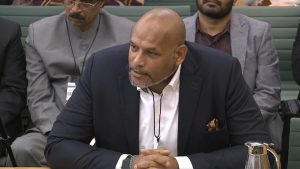
Sadly, sensationalist tabloid headlines such as those mentioned above, and the reporting style that often accompanies them, have caused long-term damage. When John Amaechi appeared in front of the DCMS Select Committee Homophobia in Sport inquiry in February 2017, he described the thought process a closeted gay athlete would have when contemplating the decision to come out:
Identity… is one of the most precious and fragile things that we have, so what you are doing when you come out is not just a statement about you, it is a statement about the people around you. You are saying to them, “Here is the most precious thing I have. I am entrusting you with it, knowing that you will take as good a care of this as I would”.
Depending on your level of celebrity, the number of people around you could be considerable – beyond friends, family, team-mates, work colleagues and employers, a footballer in the public eye must also contemplate reactions in the media, social media, and on the terraces. With something so precious as identity, even just one hurtful remark can leave a chip on a psyche that may already be brittle from shame.
The breakages stick in the memory, even though the media – including the tabloids – repeatedly shows that it does take good care of those who come out in sport. There’s a majority recognition of the human struggle and the significance – for example, The Sun called Thomas Hitzlsperger a “winner” on its front page when he came out in January 2014. However, on that occasion, the paper did also run an opinion column from football writer Andrew Dillon implying that the “desired effect” of the German’s statement was to make football “reproach itself again”, and that it had been taken to “preposterous lengths” by a TV reporter daring to ask Sam Allardyce (then manager of one of Hitzlsperger’s former clubs, West Ham) about the story. Presumably ‘Der Hammer’ wouldn’t have cared much about that – he’d already developed a thick skin by this stage. But someone else, maybe younger, still playing professionally and less confident, might read a headline that says ‘Hitzlsperger is gay… So what? Who cares?’ and retreat further into the closet, thinking their reasons for coming out would be misinterpreted by a columnist and the player himself seen as a ‘distraction’ to the serious business of the game itself. If Hitzlsperger’s story connected with you because you were a gay footballer too, you’d likely read around extensively – and even four years on, a Google search of old articles suggests what the reaction might be if you chose to come out. Negativity surrounding identity has a big effect, perhaps more so than positivity. While attention is focused on active footballers, we should recognise that retired players who happen to be gay or bi aren’t sharing their stories with journalists either. Neither are coaches, and only rarely administrators and officials… in fact, Scheckter, Atkin, Davis, and the LGBT fan groups are providing all the visibility in the pro and semi-pro men’s game.
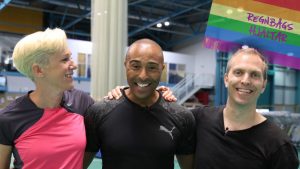
Trust between sportsmen and women and the British media on this subject has been eroded for years. When Colin Jackson came out publicly as gay last August, it was on a Swedish TV programme presented by friends and former fellow competitors from the world of athletics. There have been no follow-up interviews in the UK press. In January, a clue as to why – he settled a High Court claim over phone hacking against the now defunct News of the World. News Group Newspapers Ltd, as Defendant, confirmed Jackson’s claims that he was targeted by the tabloid from 1998 to 2010. In 2006, the paper had run a ‘kiss-and-tell’ story on the hurdler, implying he was gay. With Jackson’s privacy having been invaded in such a way, before he was ready to come out even to his own parents, it’s hardly surprising that he would subsequently avoid the British media altogether when discussing something so personal and precious.
The Hoefkens story was a reminder that if ‘sex sells’, then ‘sexuality sells’ too – and with the declining print circulation of newspapers (last month’s figures showed the Daily Star‘s was down 12% year on year), stories that combine being gay or bisexual with the nation’s favourite sport are potential money spinners or traffic drivers. The Sun‘s recent leads on homophobic bullying and a bisexual player were both picked up by several other media outlets, including LGBT-specific websites, despite being almost impossible to corroborate further. The prominence afforded to such stories strongly suggests they influence newsstand sales, even though the stated editorial intention inside the paper is to shine a light on homophobia, and the barriers that prevent gay and bi players feeling they could be more open about their sexuality if they wanted to. You don’t need a journalism degree to read between the lines, and it adds another layer of mistrust between the media and the men they claim to be championing.
As far as football is concerned, there’s at least now a widespread recognition that there are conflicting pressures in dressing-rooms, boardrooms and newsrooms which conspire against LGBT inclusion. So what can we achieve by working together?

Inclusion is defined by Frederick Miller and Judy Katz, the US diversity experts who advise Fortune 100 companies and whose 2002 book ‘The Inclusion Breakthrough‘ is an acclaimed text, as being “a sense of belonging: feeling respected, valued for who you are; feeling a level of supportive energy and commitment from others so that you can do your best”. Most big UK businesses now have senior staff assigned to D&I (diversity and inclusion), while networks such as Sports Media LGBT+ exist to bring people together, share experiences and, where necessary, raise concerns about representation. Increasingly, inclusion is part of our everyday conversation – Saturday’s Royal Wedding, for example, was a national occasion which acknowledged that diversity is something to be celebrated. Time set aside for constructive dialogue between the media and the football world on LGBT issues with the stated objective of getting the best out of individuals has to be time well spent.
So firstly, we must all try harder to ignore the ‘who cares’ brigade. To make the situation better, we need to show that it’s good to talk about inclusion, even though it’s often met with vocal opposition on social media and in the comments sections. Providing the context is well-intentioned, that should be as true for LGBT matters as for race, religion, ability, gender, age and any other part of the diversity picture. Ollie Holt, writing in his Mail on Sunday column about Darren Moore’s permanent appointment as West Brom manager, recognises this – “talk about the Rooney Rule, which requires NFL clubs to interview one BAME (Black, Asian and Minority Ethnic) candidate for coaching vacancies and is gaining some traction here, and the bigots scream about tokenism and quotas” – but, like all good columnists, he tackles the subject anyway. When Stonewall ask people who aren’t lesbian, gay, bi or trans to ‘come out for LGBT’ or wear rainbow laces, this is what they mean – talk sensibly, and ignore the screaming. On social media, we read the replies and worry, even though the ‘likes’ and ‘loves’ show support. Readers rarely comment to say ‘I agree with you’, but they do share.

Secondly, the sports media could look to counteract the more sensational stories on the front pages with articles that empower LGBT people. Charlton and Leeds are two clubs participating more fully in Pride marches this summer, while there’s been talk of an open-top West Ham bus too. The alliance of fan groups Pride In Football is having a conference in Nottingham on June 9. As the World Cup approaches, the Russian LGBT Sport Federation continues to promote inclusion; it met with Hitzlsperger in Volgograd earlier this month to discuss a planned ‘Football For All’ festival in Moscow. While the world waits for a footballer to come out, there are opportunities to amplify the LGBT voices who are already doing great work in their clubs and communities.
Thirdly, the Premier League and the football family can do more to demonstrate that authenticity boosts performance for LGBT people in football. Scheckter, an openly gay man working in the Premier League, has already spoken of the positive reception he received while at Southampton (he’s now Head of Player Care at West Ham)…
Football may get a bad rap for being unaccepting, but since telling the players and staff I’ve had nothing but support! Thank you #SaintsFC! As cliched as it sounds, it really does get better when you come out and I genuinely couldn’t be happier to have done so at this moment!
Some ideas that might help – establish an LGBT network for professional football, with support from senior leaders in the game, and ask allies to join too; encourage clubs to appoint inclusion ambassadors from within their playing staff, and make them available to speak to the media (something the NHL has done in conjunction with the You Can Play project); invite footballers from LGBT-inclusive teams such as Stonewall FC, Charlton Invicta or the London Titans (the latter two already have EFL club partnerships) into PL clubs and academies to talk about their successes, and the challenges they have overcome; and widen the remit of Kick It Out’s ‘Equality Inspires’ education programme, which is using the WONDERKID short film to facilitate conversations about having a team-mate who might be gay or bisexual. Yes, some additional education work may be required, to combat the common fear of ‘saying the wrong thing’. But that’s fine – few if any of us were taught about anything relating to sexuality or gender identity in school, so there should be no great embarrassment in having to be brought up to speed here and there.
Central to all this, of course, are LGBT people themselves. That’s not an attempt to put more pressure on any of us, but it’s essential that we are a part of this conversation. If a tabloid front page has ever caused you exasperation or, worse, distress; if an article has failed to provide the visibility that you think might have made a difference to somebody, somewhere; if there’s no representation at your club or office and, as a consequence, no concerns raised when something’s not right; if an appreciation of inclusion could have made your life better… say something. You don’t even have to come out as LGBT if you’re not ready to do so; anonymity for reasons of privacy deserves respect, but don’t let anyone allow you to think it’s your ‘secret’ to carry alone.
A recent Ipsos Mori poll conducted for the BBC showed that only two-thirds of British people aged 16 to 22 identified as strictly heterosexual. Increasingly, young people who are gay or bi are not burdened by the constraints felt by older generations. When hanging up his boots, Rogers said:
My only regret in my 11-year career are the years I spent in the closet. I wish I could have found the courage that so many young individuals have shared with me in the past five years to live honestly and openly as a gay person.
That echoes a slogan employed by Outsports, the US website that has been welcoming people into conversations about LGBT inclusion in sport for nearly 20 years – ‘courage is contagious’. It’s high time we talked about that, instead of secrets or shame.

